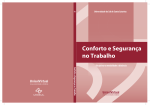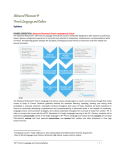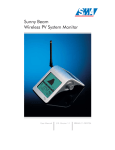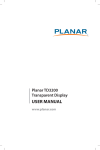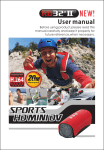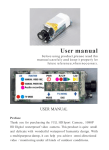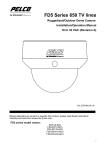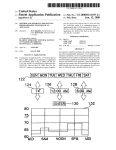Download Production Guide - Global Lives Project
Transcript
Production Guide Producing, editing, and translating a 24-hour continuous video is a wholly unique challenge. You need to plan extensively as you choose your location and participant, gather your crew and equipment, shoot your video, and prepare your video for exhibition and distribution. This guide will help you understand all steps of the process from pre-production to the final video. It is intended for individuals who have a basic understanding of video production. TABLE OF CONTENTS 3 Pre-Production 10 Day of Production 15 Post-Production Assemble your production crew.......................................3 Pay attention to the wireless mic.............................12 Documenting Your Project...................................................15 Key roles and responsibilities.............................................4 Artistic Guidelines...........................................................12 Still Photos...................................................................................16 Start planning for post-production..................................5 Take head-shots of the On-Screen Participant Video Deliverables..................................................................17 Create a fundraising plan...................................................5 (OSP), family, friends and crew.........................13 Identify shoot date and locations....................................6 Caption photos on location.......................................13 Contact local embassy for doc requirements...........6 Stay out of the way of the OSP................................13 Obtain written and/or oral release.................................7 Use a GPS logger............................................................14 Plan your equipment...............................................................7 Perform camera maintenance...................................14 Equipment Checklist.................................................................9 The ND filter/gain trap..................................................14 >> A guide to: Useful items during the shoot...................................14 Life Story Interview...........................................10 Post-production Workflow....................................................18 >> A guide to: Editing the 24-hour Video.....................................19 >> A guide to: Editing the Short........................................................22 >> A guide to: Delivering Your Media..............................................23 PreProduction The pre-production stage is the essential period prior to shooting wherein all of the necessary elements for a successful shoot must be planned carefully. As the producer, you will coordinate key details, such as the on-screen participant, shoot date and locations, crew, logistics, budgets and fund-raising. CONTENTS A >> Assemble your production crew..................................3 B >> Key roles and responsibilities.........................................4 C >> Start Planning for Post-Production..............................5 D >> Create a fundraising plan.............................................6 E >> Identify shoot date and location.................................6 F >> Contact local embassy for doc requirements.......6 G >> Obtain written and/or oral release...........................7 H >> Plan your equipment..........................................................7 SAMPLE DOCUMENTS A Assemble your production crew While crews vary in size, a smaller crew is easier to manage, costs less, and is less obtrusive to the OSP. We recommend 5-10 people. Anything less increases stress and fatigue potentially jeopardizing the production’s quality. Equipment Checklist By the end of pre-production, you and your crew should be fully prepared and equipped for your Life Story interview and 24-hour shoot. Your post-production coordinator should be ready to ingest media immediately following the shoot. Budget Spreadsheet Sample Questions for Life Story Interview Who To best gain access to and the trust of the community and best capture the spirit of the region, recruit locals or people with extensive experience in the region. They must be culturally sensitive and aware of local customs and norms. Pre-Production >> Day of Production >> Post-Production Production Guide Volunteer crew Ê If you are looking for volunteer crew members, try contacting film schools Ê Post a call-for-filmmakers on websites (ie. Idealist.org, Lightstalkers, Craigslist, Doculinks) Ê Send emails to your video production contacts to see if anyone is available or knows of others who may be interested in volunteering. Ê B Depending on the size of your crew, one person may perform more than one role (i.e., the producer may also serve as the director, the production assistant may serve as the still photographer, etc.). These roles must be fulfilled in order to successfully produce your GLP video. Responsible for the look and feel of the video. Often the producer will serve as director Ê PRODUCER Plans and oversees all logistical, technical and budgetary aspects of the shoot. Ê Identifies OSP, hires crew, oversees budget, and establishes shoot schedule and locations. Ê Coordinates equipment, media drives, batteries, vehicle(s) and transport of crew. Ê Responsible for delivering the Life Story interview and 24-hour video to GLP, per the GLP specifications. Ê Signs the production contract with Global Lives Project and typically receives the funds. Guides the technical crew (primarily camera operators), and when necessary, directs the OSP. note: Driver (optional) Interpreter (optional) Security Person (optional) Specify up front that volunteers must pay for their own international transportation (flights, trains, etc.) to and from the shoot location. Key roles and responsibilities DIRECTOR LIST OF ROLES Producer Director 4 Camera Operators Audio Engineer Production Assistant Still Photographer Community Liaison/fixer Translation Coordinator While crew members can work in shifts, the director of a Global Lives shoot must be present during the entire 24-hour production. 4 CAMERA OPERATORS Responsible for the camera work throughout the Life Story Interview and 24-hour shoot. Ê In addition to having one experienced camera operator shooting at all times, you must have a backup camera operator (BCO) on location at all times. The BCO should be proficient in operating the specific video camera and on-hand for when the experienced operator needs a break. 4 Pre-Production >> Day of Production >> Post-Production Production Guide AUDIO ENGINEER Responsible for the type and placement of microphones, the setting of levels, and ultimately capturing “clean” audio. PRODUCTION ASSISTANT Mainly responsible for off-loading and duplicating media onto hard drives and ensuring camera batteries and mic batteries are always charged and available. The PA is also responsible for securing permission and release forms. STILL PHOTOGRAPHER Responsible for capturing highquality stills throughout the day to document both the OSP and the production team at work. These will be used for our promotional materials. COMMUNITY LIAISON/FIXER Responsible for liaising between production crew and residents of the community, including the OSP. Should know the area and be fluent in native language of the community as well as a language spoken by all of the crew members. TRANSLATION COORDINATOR Responsible for recruiting and coordinating a team of volunteers to transcribe, translate and subtitle all footage in postproduction. Depending on your shoot location, you may also need to recruit a driver, interpreter, or security person. Ideally, your community liaison would serve one (or all) of these roles. Once your crew is confirmed, schedule a conference call (Skype, etc.) and/or send an introductory email to the crew, listing names, roles and responsibilities, and contact info for each person. Encourage direct communication among crew members prior to the shoot. Circulate a draft call sheet and PDF manuals of key equipment to be used, especially the video camera. C 5 Start planning for post-production Post-production for a Global Lives shoot is one of the most challenging aspects, so you should begin the process at the pre-production stage. Make sure your Translation Coordinator has a clear plan for how he or she will transcribe, translate and review 28+ hours of footage. This includes both the human and technical resources needed for this task -- a team of volunteers with access to consistent, high-speed internet. Build partnerships In addition to assembling your crew, we recommend that you build partnerships with local institutions— universities, NGOs, translation companies, community leaders, media organizations. These partnerships are extremely valuable for supporting filmmakers with post-production, translation, technology-access, and showcasing films. Pre-Production >> Day of Production >> Post-Production Production Guide D Create a fundraising plan Financial support from Global Lives Project is dependent on the availability of our funds. Although crew members are expected to volunteer their time, producers are expected to fund-raise (and/or find additional resources through volunteers) to offset expenses such as travel, lodging and rental equipment. Using crowd-funding platforms If you would like to use a crowd-funding platform like Kickstarter, the Global Lives staff will help to promote your campaign through Facebook, Twitter, and our newsletter. E Identify shoot date & locations Budget some time for getting to know your OSP, prior to shooting the Life Story Interview and the 24-hour video. We recommend that you organize a social event (dinner, etc.) In which you, the crew, and the OSP attend and get to know each other. This will make for a better, more intimate, and comfortable environment while shooting. For life story interview You will conduct the Life Story interview 1-3 days prior to shooting your 24-hour video. Allocate 4 hours (on-camera) to interview the OSP. Shoot the interview in a quiet environment, with little to no audio distraction. For 24-hour video As much as possible, determine where and what the on-screen participant will be doing during every hour of the day. Then, plan your production schedule, factor in transportation to and from shoot locations, division of labor, release forms, and your plans for navigating ever-changing lighting conditions. Plan to shoot for 26 hours: Throughout the day, expect to lose minutes here and there. You may run into a snafu or face unexpected environmental challenges, and end up losing more than a few minutes. But generally, you will need to keep the camera rolling - except for battery and SD cards changes - or you will not be able to capture a realistic 24-hour time period after editing. Make sure that you always have an awake and alert person behind the cameras (video and still) and someone close by to help out with whatever they need. If necessary, photographers can help out video camera operators; directors can take still photography shifts, etc. F Contact the country’s embassy for doc requirements If you and your crew will be coming from another country, you may want to contact the local embassy to find out what visas are available and/ or paperwork required to enter the country to shoot a documentary. For example, the Global Lives Lebanon crew had to obtain media passes to shoot in Lebanon. In contrast, the Kazakhstan crew entered the country on tourist visas. As such, we strongly advise that you record 26 hours to ensure you capture 24 hours of usable, uninterrupted footage. Maximize resources Crew members can be “recycled” from shift to shift. For example, for a rural shoot, four 6-hour shifts may be appropriate, using each team twice. tip! When entering a country, don’t offer additional details beyond what is explicitly requested. 6 Pre-Production >> Day of Production >> Post-Production Production Guide G Obtain written and/or oral release Everyone who appears on camera for more than a few seconds, or can be singularly identified, must give written or oral consent. This does not include crowds or people shot in public places. Oral release If subject is illiterate, use an oral release. In the case of an oral release, you must have a third video camera, since oral release footage must be separate from the 24-hour video and Life Story interview. The oral release script, which you will need to have translated into the local language is as follows: “ I, (name) , consent to be in the Global Lives Project video, and my image and voice can be shown anywhere for any purpose.” Written release In addition to all people who appear on camera, all crew members must sign a written release form. The written release confirms that they are participating on a voluntary, unpaid basis; therefore oral releases are unacceptable for this purpose. H Plan your equipment Here are some tips on what to consider when choosing equipment. Cameras Ideally, you should use an HD camera that records directly to an SD memory card or hard drive. You should have at least 2 HD video cameras during the day of the shoot – preferably the same model. Confirm that all camera operators are familiar with your chosen HD camera, its presets, button layout, etc., prior to shooting. Download and print user manuals and have them on hand during the shoot. If camera operators do not have experience with the camera, schedule a training session that allows for handling the camera and viewing test footage on a monitor. note: HD cameras are notoriously difficult for operators specifically in the areas of focusing and low-light performance. It is important to give operators time to set program presets for the different parts of the shoot. Pay close attention to the effects of slowshutter, gain and iris controls. 7 Pre-Production >> Day of Production >> Post-Production Production Guide Audio setup DSLRs DSLRs produce beautiful moving images, but there are many technical challenges that come with shooting video with DSLRs as opposed to traditional HD cameras. These challenges are amplified during a 24 hour shoot. Here are several issues that DSLRs present, and recommendations for proper DSLR shooting technique: -DSLR cameras are very light, and for this reason, they are not stable enough for handheld shooting. Stabilize the DSLR, whether with a tripod, shoulder mount, steadicam rig, or another reliable contraption. -DSLR cameras do not have built-in ND filters. Stopping to put on or remove an ND filter is not desirable for a Global Lives shoot. On the other hand, ND filters are absolutely necessary for daylight shooting. ND filters allow the cameraman to maintain an ideal aperture (between f4 & f11), without adjusting the shutter speed. -The shutter speed should almost always remain at 1/50. Using a 1/30 shutter speed in lowlight situations is fine, but shutter speeds higher than 1/50 are not appropriate for this style of shooting. -Regarding aperture, keep in mind that the shallow depth of field that DSLRs allow can make keeping the subject in focus a challenge. Cameramen should be confident in their focus pulling skills if they are going to shoot at low apertures. -Some DSLRs have been known to overheat. Overheating can be very problematic for a 24hour documentary shoot that requires constant filming. Test the cameras extensively to get a sense of any overheating issues. -DSLRs cannot shoot for nearly as long as traditional HD cameras (some of which allow multiple hours of continuous recording). Most DSLRs have a 12 minute limit, while some can shoot for up to 30 minutes. This means constant camera switching, and constant cuts in the continuous 24 film. DSLRs also don’t have as long of battery life as traditional HD cameras either. This means more cuts, and more disturbing the continuity of the shoot. For all these reasons, it is wise to have a traditional HD camera on set as well, whether as the main camera, or as a backup. Global Lives videos have traditionally been shot on HD cameras that did not have all these issues. Since DSLRs produce astounding footage, we look forward to seeing the videos produced by crews who overcome these challenges to create beautiful portraits of life around the world. We recommend a 2-channel mic setup with a directional mic (shotgun) mounted on the camera and a wireless lav mic attached to the OSP at all times. If you are using an HD camera that only has a stereo-mini audio input, you can acquire an adapter that will allow you to have two XLR inputs. Test your recording setup several times prior to recording. Wireless mics—even the most expensive ones—break regularly, so bring backup solutions. tip! Bring both a backup set of wireless mics and an extralong XLR cable and the appropriate mount in case you need to turn your shotgun mic into a boom. If you’re traveling to a remote location for the shoot, you probably won’t want to bring a boom pole, but you should identify a broom handle or something else on location that can be made into a boom if necessary. 8 Pre-Production >> Day of Production >> Post-Production Production Guide Equipment Checklist It’s best to use a bus-powered hard drive if you’ll be operating in locations Video Main video camera (preferably 1080p where you can’t plug in the hard drive to electricity. Reflector/bounce card (in the event you shoot Life Story Interview outside) Memory cards – The number of memory cards will depend on various factors, includ- 24fps) Second video camera (best if identical to main camera, for use either in rotation or as backup) Third video camera (optional - can be a small camcorder or phone camera - for behind the scenes/oral release footage) Tripod (for sleeping hours and Life Story interview) Extra batteries and external chargers ing the type of camera you are using on the For example, the Sony EX3/EX1 shoots Digital SLR HD video at 35mbps so you get about Batteries for DSLR 112 min on 32GB cards. A Canon C300 shoots HD video at 50mbps so you get about 82min on 32GB cards. cially in hot climates. Miscellaneous 2 shotgun mics (main and backup) Extra laptop batteries Laptop and external media drive – 2 media hard drives: One for off-loading footage and photos from memory cards, the other for duplicating the media (in case a hard drive fails, which is a regular occurrence). Steadicam Production van (nice to have as a base for the shoot and a place to take (main and backup) batteries as much as possible. to off-loads photos. Optional more footage on the cards. Refer to the user manual. tectors/splitters so that you can charge Laptop and hard disk compressed HD and, as a result can fit last only 30% of what they are rated, espe- Power extension cords and surge pro- Extra memory cards Consumer HD cameras shoot highly camera manufacturer’s website or the Extra batteries for mics Photography shoot. for all cameras. Estimate that batteries may 2 wireless mics chamois etc.) GPS Logger, USB cable and batteries Gaffer tape Safety pins a nap!) Portable light (don’t bring anything too big or intimidating) Generator (for locations without electricity) Zip ties Food and drink for the crew: Sandwiches, energy bars, caffeinated beverages, etc. Get food that won’t make a mess and can be eaten and cleared away quickly. Camera assistant pouch (blower, cleaner, note: Please make sure you keep receipts for all expenses associated with your shoot. You will need to produce these to get the second payment. For situations where receipts cannot be obtained (i.e., informal economies), please make notes of each transaction. 9 Pre-Production >> Day of Production >> Post-Production Production Guide a guide to: LIFE STORY INTERVIEW >> Life Story Interview << Editing the 24-Hour Video Editing the Short Delivering Your Media The Life Story interview is one of three videos you will produce and deliver as part of your Global Lives video production. Unlike the 24-hour video, in which your crew captures the On-Screen Participant (OSP) spontaneously moving through daily life, the Life Story Interview is your opportunity to sit down and interview the participant in a controlled environment. It is also an important time for the OSP to become more comfortable with and natural in front of the camera. In addition to the video itself, the Life Story interview will provide the basis for which you will write the contextual essay about the OSP. Portions of the interview may be re-purposed as part of the 2-3 minute short you will create. As with the 24-hour video, the Life Story Interview will appear on the Global Lives website in its entirety and may be screened and exhibited in many forms across the globe. Guidelines for conducting the interview Ê Ê Ê Ê Ê Ê Get to know your OSP prior to the interview. Prepare questions in advance. Find a calm, quiet, private place to conduct the interview Conduct the interview at least one day prior to your 24-hour video shoot. Interviewer shall remain off-camera during the interview, though the OSP should look at him/ her, not the camera. Budget four hours to conduct the interview. Prepare questions and your OSP When conducting a life story interview, it’s critical to have a set of prepared questions to guide the interview. That said, the questions are meant only as a starting point to structure a fuller, more genuine conversation. Pursue interesting topics as they arise, and feel free to be creative and steer the interview in whichever way feels appropriate in the moment. It should simply be a warm, personal, long conversation. Before you begin, remind your OSP that if they make a mistake, they should start their sentence from the beginning. They can take time to think about their answers, and if there are any questions they don’t want to answer, they don’t have to. The OSP should answer in complete sentences. One tip to accomplish this is to ask two questions at once: for example, “What is your name and age?” These will make the interview flow better and make editing easier for the short. Conversation topics include (but are not limited to): name, age, current home, where born and where they grew up, upbringing, schooling/education, major challenges and accomplishments, hobbies, relationship status, living situation, travel, religion, lifestyle, family (partner’s, parents’ and children’s names, ages, location, work), prior and current work experience (hours, schedule, income, role, describe typical work day). 10 Pre-Production >> Day of Production >> Post-Production Production Guide Conduct interview in the OSP’s native language Conduct the interview in a quiet space Normally the producer or director conducts the interview, although if he/she does not speak the OSP’s native language, it should be done by your local liaison (rather than a translator) to conduct the interview. Your interview space can be indoors or outdoors, but it should be in a private place and free of distraction and interruption (i.e. radio, television, people, traffic). Select an interesting background for your OSP, and consider the time of day and location so that there is good, even, and continuous light; alternately, use a lighting kit.. Limit the number of people “on set” for the interview Having a large group on-set for the interview can be intimidating for the OSP and can hinder the OSP from sharing critical aspects of their story. Camera angles Feel free to use a variety of shots (wide shots, medium shots, and close-ups) during your interview. You can also use more than one camera if you want. Some online resources for conducting a life story interview Ê-USEUMOFTHE0ERSON)NTERVIEWERÃS-ANUAL Ê,IFE3TORY)NTERVIEWÀ-C!DAMS Ê#REATEYOUR,IFE3TORYÀINCLUDESSAMPLE segments and questions Ê.ORTHWESTERN4HE,IFE3TORYINTERVIEW Ê(OWTO#ONDUCTA3TRONG)NTERVIEW 11 Day of Production It’s time to capture the raw footage! Unlike most video productions, a Global Lives Project video is shot continuously over a 24-hour period. There’s no editing. There’s also no second take. Your camera operators and audio tech will be closely following and recording your OSP for 24 hours. A Pay attention to the wireless mic Ask your OSP to try not to fiddle with his/her wireless mic because it compromises the sound recording. Keep an eye on it and if it is moved, readjust it during a down moment. This will minimize audio editing in post- But GLP has 2 specific artistic guidelines that we use to maintain some consistency across projects, and give viewers a specific kind of experience: 1. Shoot with the “long take” approach in mind B Artistic guidelines This is a camera perspective unbroken by editing. When you assemble the full 24 hours of footage, edits should only occur when necessary for production. When changing footage cards, tapes, and/or batteries you may need to switch to a second camera quickly. Try to have your second camera in place to pick up visually where the first camera has left off. Maintaining an “unbroken” perspective on the day is important to the experience of the viewer, allowing viewers to have an “unblinking eye” on the day. E >> Stay out of the way of the OSP.....................................13 Artistic choices during production are up 2. Maintain an OSP perspective F >> Use a GPS logger...................................................................14 to you and your team. Camera angles and choices of who/what to have in frame are up to you. Keep your OSP within camera frame as much as possible. It may be interesting to adjust the frame to show what your OSP is looking at, or their surroundings. But when the OSP is off-frame the viewer is for a short time not experiencing their existence. production. CONTENTS A >> Pay attention to the wireless mic.................................12 B >> Artistic Guidelines.................................................................12 C >> Take head-shots of the OSP, family, friends and crew.......................................................................13 D >> Caption photos on location...........................................13 G >> Swap out media cards and batteries......................14 H >> Beware the ND filter/gain trap.....................................14 I >> Have these useful items during the shoot................14 Pre-Production >> Day of Production >> Post-Production Production Guide C Take head-shots of the OSP, family, friends and crew. We need at least one really great photo of the OSP from almost every hour of the day. These will go in Global Lives Project’s promotional materials and on the website. We need head-shots of each crew member, as well as family members and close friends/colleagues of the OSP. Also, get some group photos of the family and the crew. Head-shot guidelines Head-shots should retain a shallow depth of field for maximum impact. An outdoor setting is ideal as it makes use of natural light, avoids a staged appearance, and puts the subject in context with his/ her surroundings. D Caption photos on location. It will be much easier to write captions later if the photographer takes notes during the shoot. The photographer should capture peoples’ first and last names (these will need to correspond to release forms and log), names of places, how long OSP spends in each place, etc. Include as much concrete information as possible, including what is pictured and any relevant cultural/ historical context. Photos will eventually become part of our photo database, so think about search terms people might use to find your image. KAI LIU 2008, Anren, China Sometimes Kai visits nearby farms to buy fresh produce directly from farmers. Here, he’s looking at some wosun, a Chinese cabbage. Kai works two jobs: as a manager of a convenient store and as a purchasing officer for a school. Photograph by Chieko Kato www.chiekokato.com/ Captions must also include the full name of the photographer. E 13 Stay out of the way of the OSP! Minimize the number of crew members following the OSP around. For example, the still photographer does not need to be there all the time. The fewer crew members in the immediate surroundings of the OSP, the better. tip! The best situation is to simply have the camera operator on the spot, and their assistant and the photographer (along with the community liaison) hanging back as far away as reasonable. The assistant can have a walkie-talkie with a headset or a cell-phone and can be the bridge to the rest of the crew. Pre-Production >> Day of Production >> Post-Production Production Guide F Use a GPS logger. A GPS logger/tracker is a simple yet important element of the shoot. It will allow us to map the OSP’s trajectory during her day and show which photos/ videos correspond to which locations. tip! Test the GPS logger as you test your camera. Make sure that someone from each shift is able to verify that the GPS tracker is working properly. Check the battery life, and find out whether you will need to download data from it during the shoot. G Perform camera maintenance. Double-checking all key aspects of your camera throughout the shoot day is crucial. In addition to the most critical maintenance (changing camera batteries and SD cards) you need to make sure that all settings are still correct on the camera (check for accidental button pushes or switch flips), clean the lens, change mic batteries and then get back in and keep shooting. H The 2008 Global Lives China crew introduced the use of Alfred Hitchcock’s technique pioneered in Rope (1948) for producing seamless edits by ending each tape with the frame close in a stationary object that fills the entire screen with a solid color briefly, and then starting the next tape on the same image. While this is not required, it is a recommended technique, as it will minimize playback interruptions during exhibit. Beware the ND filter/gain trap. Many of the shoots will be moving in and outside, from light to dark spaces. When a shooter is trying to simply keep up with the action, she may forget the ND filter and gain settings that were adjusted for a different lighting situation. Please be conscious of this! I Have these useful items during the shoot. Aside from video and audio equipment, make sure you have the following items on-hand during the shoot: Stack of release forms Food and drink Call sheet Shoot schedule Cash 2 walkie-talkies 14 PostProduction Post-production involves substantial documentation about your project, organizing your media, assembling your edits, delivering your media, and also translation, transcription, and review. You should not attempt this large task on your own. Seek the support of a number of volunteers and, preferably, the support of an institution. Start right away! The longer you wait to begin the post-production process, the more difficult it will be to complete it. note: You must complete postproduction within a maximum of four months after the shoot. The second installment of Global Lives Project funds will not be released until postproduction is complete. CONTENTS A >> Documenting your project..........................................15 B >> Still photos..........................................................................16 C >> Video deliverables..........................................................17 D >> Post-production workflow............................................18 >> a guide to: Editing the 24-Hour Video >> a guide to: Editing the Short >> a guide to: Delivering Your Media SAMPLE DOCUMENTS Shoot Debrief Essay A Documenting your project While the experience is still fresh in your mind, sit down and document your thoughts about what happened, what it all means, and who did what. (Please include these documents among all your deliverables.) Shoot debrief (a.k.a. director/producer’s statement) Write down all of your observations about the day of the shoot and the preparations — what went well, what went wrong, what you would do differently in hindsight. When you’re done with post-production, add to the statement, summing everything up. Tell us exactly how long the process took, how you managed the tasks, where the bottlenecks were, and how this could be done more efficiently. Pre-Production >> Day of Production >> Post-Production Production Guide Contextual essay Write an essay (up to 2,000 words) covering the subject’s day, life story, and important local, regional, and national context issues that shape their life. Include in your essay some information about : Ê The population of the country and city/town/ village you visited Ê Political-economic characteristics of the region Ê History of the region Ê Demographic characteristics of the subject (age, income, religion, etc.). Ê Description of family Crew list and bios With the essay, you must also submit a final list of the crew members who participated, their short bios (up to 100 words each), and their credits for the shoot (camera operator, director, etc. — or whatever terms you like) as these will be posted on our website as well. tip! Be sure to double-check all facts and have other members of your team read it over to get their feedback and any additional contributions. B Still photos After the 24-hour shoot wraps, review your still photographs and select 50–100 of the best images. Write captions for your selected photos and include them with your other deliverables in the Producer’s Metadata spreadsheet. Include a portrait of the On-Screen Participant, their close family members and friends, and every crew member who participated, as we will be featuring these on our website and in exhibitions. Please be sure to include their full names in the captions. Make sure your subject portraits retain a shallow depth of field for maximum impact. An outdoor setting is ideal as it makes use of natural light, avoiding a staged appearance and making the subjects feel more connected to their surroundings. Photo captions Captions should be written in complete sentences and include as much concrete information as possible, including what is pictured and any relevant cultural/historical context. Photos will become part of our photo database, so think about search terms people might use to find your image. Captions must also include the full name of the photographer, along with the date and location of your shoot. 16 Production Guide C Video deliverables You will be responsible for creating various videos involving your OSP. Unlike the 24-hour video, in which your crew captures the OSP spontaneously moving through daily life, the Life Story Interview is your opportunity to sit down and interview the participant in a controlled environment. [See “Life Story interview” guide.] Life-Story Interview The 24-hour video fulfills the Global Lives Project mission: to build a video library of life experience that reshapes how we as both producers and viewers conceive of cultures, nations, and people outside of our own communities. This video combines all the footage you shot during the 24hour time frame into a seamless whole. 24-Hour Video [See “Editing the 24-hour video” guide.] Your short video can take many approaches. In 2-3 minutes, it should convey a sense of the 24-hour shoot and/or give a teaser-like feel of that day. The short will be viewed by a wide variety of people, so it should make a lasting impression. [See “Editing the short” guide.] Short Video Pre-Production >> Day of Production >> Post-Production 17 Pre-Production >> Day of Production >> Post-Production Production Guide D Post-production workflow There are several things to keep track of during the post-production phase of your project. Attention to detail is critical to keep the project from getting out of control, and to make the finished product look the best it can be. Ingesting media This refers to the process of importing different types of video, audio, or image files into a video editing program. The process depends on your source media: filebased (a.k.a. tapeless) or tape-based. The important thing is to get all your media in one place that’s easily accessible so that you can create the 24-hour video as well as the short video about your subject. [See “Editing the 24-hour video” guide.] Audio finishing Sometimes called “audio sweetening,” this involves reducing any “noise” and making the audio sound as pleasant as possible. For the full 24-hour shoot, this need only be done for situations where there are significant problems with audio levels that suddenly peak too high and could distract your audience. You’re basically making only minor sound adjustments to achieve a uniform playback experience. [See “Editing the 24-hour video” guide.]] Color correction [See “Editing the 24-hour video” guide.] Encoding and compression We use Archive.org as our main video hosting and storage platform, which encodes and compresses uploaded files automatically, so you do not need to be concerned with this process yourself. We also have an automated process for transferring videos from Archive.org to YouTube and Dotsub, which we use for all subtitling. Media labels As you ingest media, you will need to rename each file according to our guide. It is crucial that files are named consistently, accurately, and according to standards, so they will be consistent with all the other projects. Please be sure to place all the files in one folder as well. [See “Editing the 24-hour video” guide.] Media delivery After you finish your videos, you will need to either upload the footage to Dropbox.com or ship all of your footage on a hard drive to Global Lives, so that we can deliver the files to Archive.org. [See “Delivering your video” guide.] 18 Transcribing, translating, and review Once the footage is uploaded to Archive.org, we will transfer it all to YouTube and Dotsub. You are then responsible for coordinating all transcription and subsequent translation of all three video deliverables. Recognize that this is a mammoth task! We strongly suggest that you recruit a team of transcribers (who do not necessarily need to speak English) to get all footage transcribed as quickly as possible. [See “Translate your video” guide.] Pre-Production >> Day of Production >> Post-Production Production Guide a guide to: EDITING THE 24-HOUR VIDEO Life Story Interview >> Editing the 24-Hour Video << Editing the Short Delivering Your Media Storage needs You will need a minimum 1 TB drive to store all your raw media, assuming that you are shooting in HD on solid state media. The video will require approximately 600 GB, as each 32 GB card holds about 90 min. of HD video at 35 Mbps (less for cameras shooting 50 Mbps but more for cameras shooting 20 Mbps). To ensure sufficient space for all of your captured footage, scratch folder (for color/audio-corrections), and final exported footage, you’ll need closer to 2 TB. Make sure that your audio/video settings are configured for HD and the type of video that you collected (1080p24 is preferable). If you do plan on cutting footage from different cameras together, stick with one setting. Make sure each SD card remains in its own single file — even if your camera operator happened to stop the 19 This is the most involved part of the post-production process even if it’s not the most creative. You are combining the various footage you shot during the 24-hour time frame into a seamless whole. It’s a big media management and asset storage exercise but it’s a crucial part of your project’s success. >> CONTENTS Storage Needs Media Ingest Assembling the Edit Edit Log Audio Finishing Color Correction >> SAMPLE DOCUMENTS Edit Log camera for any reason (battery change, etc.) during a shoot — to avoid unwanted breaks. Media ingest Ingest involves importing different types of video, audio, or image files into a video editing program. We strongly recommend that you use file-based (a.k.a. tapeless) source media, not older, tape-based formats. Get all your media in one place that’s easily accessible so that you can create the 24-hour video as well as the short video about your subject. Below are some resources to help you understand the process, depending on the tools you use and level of prior experience. Adobe Premiere Pro: Importing assets from tapeless formats Apple Final Cut Studio: Ingest methods based on media type Media labels It is crucial that you label your media assets (pertaining to the 24-hour video, Life Story, and short) properly. Consistently named files will help others identify your files without having to ask you what’s what. Should an asset ever become separated from the others, the filename should indicate what it’s part of. Because we will later select some of your images and use your essay for promotional purposes, it’s essential to document everything so that it can be properly identified later by someone unfamiliar with your project and the people involved. Configure your video-editing program to import files named correctly. Pre-Production >> Day of Production >> Post-Production Production Guide Final media should be labeled as follows: globallivesproject_(Full Name*)_(Year Produced)_(ISO 639-3 languagecode)_ (city/town/village**)_(ISO 3166-2 country/state code***)~######-######**** * Names are case-sensitive. Separate first, middle, and last names with an underscore (e.g., Leonardo_da_Vinci). Photo #2 globallivesproject_Jamila_Jad_2009_ara_Beirut_LB-BA_002.jpg Release form globallivesproject_Jamila_Jad_2009_ara_Beirut_LB-BA_release_form.pdf You can now deliver your video. [See the section on Media Delivery.] ** City/town/villages are case-sensitive. When names of places have more than one part, Separate each piece with an underscore (e.g., Dar_es_Salaam). *** Look up ISO 3166-2 country/state codes. **** ######-###### Is a count up in time code with hours, minutes, and seconds. Start at 000000 (midnight) and go to 235959 (one minute before midnight the next day). Even if your shoot started in the middle of the day, be sure to organize files according to this structure so anyone can easily reference what is happening at what time of day. This portion of the filename is relevant only for video files. Examples of labeled media and deliverables 24-hour video (first hour, t = 0 to t = 00:59:59)globallivesproject_Jamila_ Jad_2009_ara_Beirut_LB-BA~000000-005959.mov Life Story interview (part 1) globallivesproject_Jamila_Jad_2009_ara_Beirut_LB-BA~000000-001500_life_ story_parent_interview_part_1.mov Short video globallivesproject_Jamila_Jad_2009_ara_Beirut_LB-BA_short.mov Oral release reel globallivesproject_Jamila_Jad_2009_ara_Beirut_LB-BA_oral_release_reel.mov Life Story parent interview photo #46 globallivesproject_Jamila_Jad_2009_ara_Beirut_LBBA_life_story_parent_ interview_photo_046.jpg note: Please be careful to preserve any placeholder zeroes in your filenames: longname_photo_001, longname_photo_002, longname_photo_003, etc. Ask us if you have any questions about these naming conventions. See Archive. org for more video naming and audio naming guidelines. For other files you deliver (release forms, edit log, clearance report, bios, essay), try to follow the same basic naming convention but put different words and extensions at the end of each. For example: longfilename_crew_essay.txt, .doc, .pdf, or .html. 20 Pre-Production >> Day of Production >> Post-Production Production Guide Assembling the edit: achieving picture-lock Once you have off-loaded and stored all media from the camera, make one 24-hour timeline in your edit software. (If you’re using an older editing programs, you may find that 12 hours is the limit for a timeline, so you’ll have to make two 12-hour timelines.) Lay the clips into the timelines in chronological order. Adjoin the clips using one-second fade-to-black dissolves. You don’t want to introduce any editorializing or fancy effects; you are simply documenting the 24 hours of your on-screen participant (OSP) like a fly on the wall. Review all the footage Edit log Record in this document anything of interest or concern about the 24hour video while keeping track of the time code so you (or anyone else) can find the exact, relevant video segment later. Items to record include: people who come on screen and their release form numbers, portions of the video that you black out, major adjustments to audio and color (and why), etc. Audio finishing Sometimes called “audio sweetening,” this is where you reduce any noise and make the audio sound as pleasant as possible. For the full 24-hour shoot, this need only be done for situations where there are significant problems with audio levels that suddenly peak too high and could distract your audience. You’re basically making only minor sound adjustments to achieve a uniform playback experience. Any audio sweetening should be noted in the edit log. 21 Color correction Given the various (possibly uncontrolled) lighting situations encountered during your shoot, you may need to correct colors to match the footage shot by different operators or with different cameras throughout the day. Any color correction should be noted in the edit log. Below are some resources to help you understand the process depending on the tools you use and level of prior experience. Adobe: Premiere Pro - Color correction and adjustment Premiere Pro - Three-way Color Corrector effect Apple: Final Cut Studio - Color correction Vimeo: Introduction to color correction You are now picture-locked. This is the final 24-hour film. You can now deliver your video. See the section on Media Delivery. note: While you should strive at all times to depict everything that occurs during the 24-hour shoot, please be sensitive to situations that might, in retrospect, make the OSP feel uncomfortable or actually compromise his or her safety later. (Examples: drug use, profanity, or domestic intimidation.) If the OSP raises the subject, consider omitting that portion of your footage. Pre-Production >> Day of Production >> Post-Production Production Guide a guide to: EDITING THE SHORT 22 After you edit the 24 hours of footage about your subject into a seamless whole, you will need to cut a short film or summary video based on that footage. Shorts can take many approaches, sometimes making an effort to convey the overall sense of the entire 24-hour shoot and sometimes giving a teaser-like feel of the longer shoot. The short will be viewed more than the full shoot, so it should make an impression. This short will be put on our website and promotional DVDs. Life Story Interview Editing the 24-Hour Video >> Editing the Short << Delivering Your Media Guidelines on making a successful Global Lives Project short film >> Do NOT show any credits or bumper in your short. >> Use only music that comes from the recording itself. >> Keep the duration between two to three minutes. Although earlier shorts were inconsistent about this, we now prefer that you just fade in from black at the beginning and fade out to black at the end. You may include credits information (crew members, OSP, all people who appear prominently on camera) in a text file that you include with your other deliverables so that we can add them later when we upload your short to YouTube and other sites. Do not add any prerecorded music. For your post-production to be considered complete, we ask that you keep it really short for the casual website visitors who will view it. We welcome you to create some alternate shorts of varying lengths that can be shown to audiences with different interest levels and expectations, such as gallery visitors (5-10 min.) or film festival moviegoers (15-20 min.), etc. >> Be creative with your content. Feel free to take it in any direction that makes sense for your subject. >> Ensure that the video can be displayed correctly in the 16 x 9 aspect ratio. Also try your best to select a high-quality preview image (poster frame) for your short we can later assign to the posted video. This way, our shorts page will maintain a professional look. Important: Output your short in Apple ProRes 422 format so that it can be integrated easily into longer, similarly formatted videos in the future. (Also feel free to supply your edit software’s project files.) Learn by example. See some recent examples of our shorts on the website and be inspired by what others have done before you. Like the trailers (“previews of coming attractions”) for major motion pictures, your short video should be attentiongrabbing and make people want to watch more. You can learn from Hollywood trailers, even though your short serves a different audience, purpose, and expectations. Pre-Production >> Day of Production >> Post-Production Production Guide a guide to: 23 Delivering your media is relatively simple but requires some forethought. There are two primary destinations for your deliverables: the Internet Archive and the Global Lives Project website (and others, such as YouTube and Flickr). DELIVERING YOUR MEDIA Life Story Interview Editing the 24-Hour Video Editing the Short >> Delivering Your Media << Archiving As a permanent electronic repository, the Internet Archive documents the totality of your 24-hour shoot. We will store all of your raw, source footage, still photographs, recordings, etc., in the archive. Because the size of this entire media is huge, you will most likely need to ship a hard drive or two directly to us for secure storage and backup. Supplementary Materials The supplementary materials involve selective portions of the entire project so that they are easily digestible by the ordinary public, as well as media that adds context and richness to your shoot. These include your short film, the Life Story Interview, the most interesting still photographs, >> CONTENTS Archiving Supplementary materials Video format Still photos Uploading files or sending hard drive(s) >> SAMPLE DOCUMENTS Metadata spreadsheet Hard drive folder structure behind-the-scenes footage, etc. All of these should be uploaded to Archive.org or sent on hard drive to us directly. Video format If you’re using a professional-grade camera, saving your final, edited video files in Apple ProRes 422 format ensures a high-quality picture format that others can edit later if necessary. However, use good judgment: don’t make the output files larger than the original files produced by the camera. If you are using a consumer-grade camera, for example, output your video files using the same (native) format used by the camera. If you are unsure, try a generalpurpose, high-quality format, such as high bit-rate (5-7 mbps) H.264. Still photos When you are ready to submit the 50-100 photos and completed captions, contact production@ globallives.org for information about how to upload all photos to Dropbox.com. If you can’t access Dropbox, you can also include the photos on the hard drive(s) you mail to Global Lives. Pre-Production >> Day of Production >> Post-Production Production Guide Uploading files or sending hard drive(s) Here are the basic steps to complete your project: 1.) After your 24-hour video is picture-locked, divide it into 48 30-minute clips, naming your video files according to the rules described in “Media Labels” above. Global Lives Project Address: Global Lives Project 145 9th St., Suite 102 San Francisco, CA 94103 USA 2.) Email [email protected] for the “GLP Producers Metadata Template.” Complete the metadata spreadsheet with clip descriptions and file names. Global shipping: 3.) E-mail the metadata spreadsheet to production@ globallives.org for approval. FedEx Upon approval, choose one of the following delivery options: a.) Upload your final footage to Dropbox.com following the instructions you’ll receive from us once your metadata spreadsheet is approved. It will be important to do this from a location with a very high-speed Internet connection, such as a university or large company. b.) Ship the hard drive to us (address below), making sure to save a local copy on your own hard drive until you’re notified that we received the shipment in satisfactory condition. If there is space on the drive to include the raw capture files, please send those as well. Please budget for shipping the drives with insurance and use a reputable delivery company that can provide a tracking number. DHL NEX Worldwide Express 24



























